AKR in Oman Part 2: # 1 “The Muscat Festival 2011”
AKR in Oman: Part 2: The Muscat Festival 2011
Welcome back to Oman! This is my second visit to Oman as a Research Fellow of the Sultan Qaboos Cultural Center in Washington D.C., an extension of the Royal Court or Diwan of the Sultanate of Oman.* This visit is timed strategically to coincide with the Muscat Festival, a month long city fair, celebrated around this time every year. The festival now in its 10th year seems to be superbly produced, carefully designed, and well executed. The combination of exhibitions of crafts and industry, performances by local and international artists, and fun and education for kids is held in a beautiful venue called Qorm Natural Park, a vast area adjacent to a preserve of mangrove trees (Qorm) and less than a kilometer from the Arabian sea. This mangrove preserve lines a canal that feeds into the ocean. It is visible from the corniche, walkway, and road, nicknamed “Love Street” (tariq al- hubb) where couples, friends, and families come to stroll, jog, or just hang out. Weary travelers longing for a pick-me-up can quench their thirst for a laté or macchiato at the “Love Street” Starbucks.
Figure 1: A view from the balcony of Starbucks: The Mangrove Preserve is visible on the right and Qorm Natural Park, the site of the Muscat Festival. To the left on the hill you see the Crown Plaza Hotel, Tariq al-Hubb and the Arabian Sea.
Despite the fact that the park is located in one of the nicest and most elite neighborhoods of Muscat, the festival is accessible to all: daily adult tickets are 200 Baisa, about fifty cents.
The Muscat Festival is organized by the Muscat Municipality, and its mayor Sultan bin Hamdoon al-Harthy. Although I met Mr. Harthy, when I was here in February I am hoping to be able to find the festival planners and programmers who can give me a better picture of their vision for the festival, its scope, their goals, and how the festival has developed in its ten year history. It is clear that this festival shares many of the features of the kinds of community celebrations, from the county fair to the Smithsonian Festival of Folklife with which I am familiar. While the “heritage village” site of the festival is quaint and contrived as are all “framed and re-contextualized” performances of material culture and performance, the women and men who share their arts and crafts are real. Whether it is a drum maker from Sur, or women specializing in the chemistry of the fragrances, (frankincense and myrrh among them) for which the region is infamous, or artisans involved in the textile arts, basketry, and various agricultural processes, like threshing wheat or hauling water, the carriers of these tradition are on hand to explain the techniques of their work and their importance in Omani culture. And while purists may argue that such quaint, staged representations are the antitheses of authenticity I think we can also see how these decontextualizations are also important and inevitable re-contextualizations in any society.
In addition to Omani crafts and heritage work are a number of foreign artisans — an ‘ud maker from Syria, a calligrapher from Turkey, specialists in the textile arts from India – are also in the mix. [More on the international presence in a future post.]
The Ministry of Information plays an important role in publicizing, interpreting, and reinforcing the festival experience with live radio broadcast from the festival grounds, evening broadcasts on Omani television of various performances, and at least some reporting, every day, on the festival in all of the daily papers.
Folklore: Natural, Official, Unbounded?
Of course, my attention is drawn to the performers. On the first evening I was fortunate to run into Al Nojoom (the stars), a troupe from Sur that travels widely, both in Oman and internationally within and outside of the Middle East. Al Najoom performs a variety of music and dance genres that fall, officially, under the rubric of Traditional Arts or, in Arabic, al-Funun al-Taqlidiyya. The nomenclature and status of these kinds of regional folk musics and dances have been elevated and collected as consciousness about patrimony, history, and heritage have developed in this relatively young nation with a decidedly old history. The process of rebranding the music, dance, and material culture of a people is not unlike what has happened in many other countries, like my own, where practices of the “un-elite” have been renamed and repurposed, expanding to occupy multiple contexts. Such processes have inspired endless debates about faithful representations – what I have called “the real version” in an article I wrote for the volume Performing Ethnomusicology [1] that are as much a part of the discourse of practitioners as they are among audiences, critiques, and scholars.
Figure 2: Al Nojoom presented an array of music and dance in a participatory parade flanked by the festival audience and documentarians, like myself, until they reached a stage where they performed facing an audience.
From what I learned from one of the group’s members and in visiting with Majid al-Harthy, a fellow ethnomusicologist and professor at Sultan Qaboos University, Al Nojoom is not an officially sponsored or trained folkloric ensemble, rather they are self motivated, self managed and thus have a great deal of freedom regarding the breadth and style of their repertoire. (And I just called Omar from the group to confirm this). That Al Nojoom is free standing ensemble of men and women, musicians, dancers and singers who perform styles and genres from various regions of Oman is significant for at least a couple of reasons. First, that the group is in demand outside of official presentations (or representations) pushes this traditional art into the realm of the popular and the commercial. Second, because Al Nojoom chooses to perform a diversity of genres and styles, the group is not only versatile, but proof, that like in many places in the world, folk arts are not only tied to specific regions but also participate in the processes of fusion, diffusion, and innovation that are endemic to any healthy music culture (however prickly they are for the musical taxonomist to describe).
Figure 3: A group from Sidab, a neighborhood in Old Muscat, perform Malid. The facing rows, the kneeling position, their shoulder-to-shoulder stance, and the way they swoop their arms and bodies down to the ground and out behind them connect this performance style to other religious performances around the Indian ocean, while at the same time being completely unique, in its detail to Oman.
Traditional Spiritual Arts?
Another group that I found completely compelling comprised two lines of men performing Malid. Their song and movement is clearly related to the great variety of language performance that is characteristic of the Islamicate world, but seems, at least to my eyes and ears to be unique to Oman.
The rais or leader of the group sings out lines of text that are either repeated or complimented by the group’s response. For several of the “songs” the opposing lines of men kneel, shoulder to shoulder, and sway, bowing down to the ground, sweeping their left arms forward and to the right side and then bringing their arms across the body and back behind their sides to the left. The texts certainly celebrate and narrate the life of the Prophet Muhammad and are likely to come from poetic biographies of the Prophet’s life, by Barzjanji, or Ibn al-Jawzi. According to Shawqi’s Dictionary of Traditional Music in Oman, (compiled 1985-87) revised and expanded in English translation by Dieter Christensen (1994), Malid recitations, held in celebration of the birth of Prophet, are performed on a wide variety of occasions that mark both the Islamic calendar, as well as on occasions that celebrate life cycle events (weddings), or to bring blessings on the consecration of a new place or process (building a house, leaving for a journey) or as a catalyst for change (for someone sick or in danger or in need of a little extra good luck). Incanting religious language with repetitive movement, usually, in an Islamic context, associated with Sufism, is also a mechanism for communal and individual experience of “the divine” broadly defined. But Sufi performance has long been adapted to the proscenium stage for concerts, festivals, conferences and even restaurants throughout the world. In the case of this Malid group from Sidab, an area within old Muscat, their performance space was an elevated corner of the “Traditional Village.” They were both in public and alone. They were in their own separate space but available to the public. They were both in private and completely accessible as I discovered when I approached them. As with every advance I have made in this incredibly hospitable country I was received with warm enthusiasm and, in the case of the men of Malid, with a small cup of warm spiced milk: “good for the throat” they assured me. They must know. They perform on and off for five hours a day throughout the duration of the festival.
Figure 4: The men of Malid from Sidab also perform standing and with interlocking frame drums, called daff or duff, that are used throughout the middle East and Muslim World.
I hope to write more about the spectacular festival grounds and the use of space in my next post, stay tuned.
AKR
References
*More information about the Sultan Qaboos Cultural Center may be found here:http://www.mei.edu/SQCC/AboutSultanQaboosCulturalCenter.aspx
[1] Rasmussen, Anne K. 2004. “Bilateral Negotiations in Bimusicality: Insiders, Outsiders and ‘the Real Version’ in Middle Eastern Music Performance.” In Performing Ethnomusicology. Ed.by Ted Solis, University of California Press. Pp. 215-228.
[2] Shawaqi, Yusuf. 1994. Dictionary of Traditional Music in Oman. English edition revised and expanded by Dieter Christensen. Wilhelmshaven: Intercultural Music Studies, Florian Noetzel Verlag.
Comments are currently closed. Comments are closed on all posts older than one year, and for those in our archive.

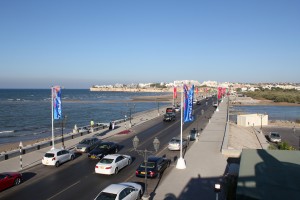
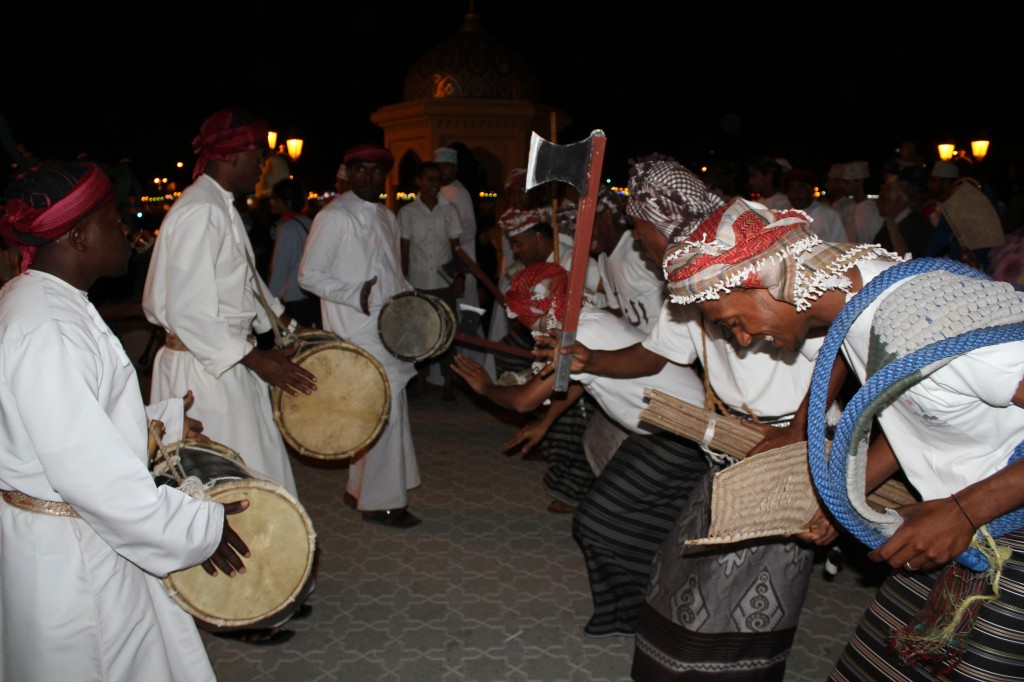
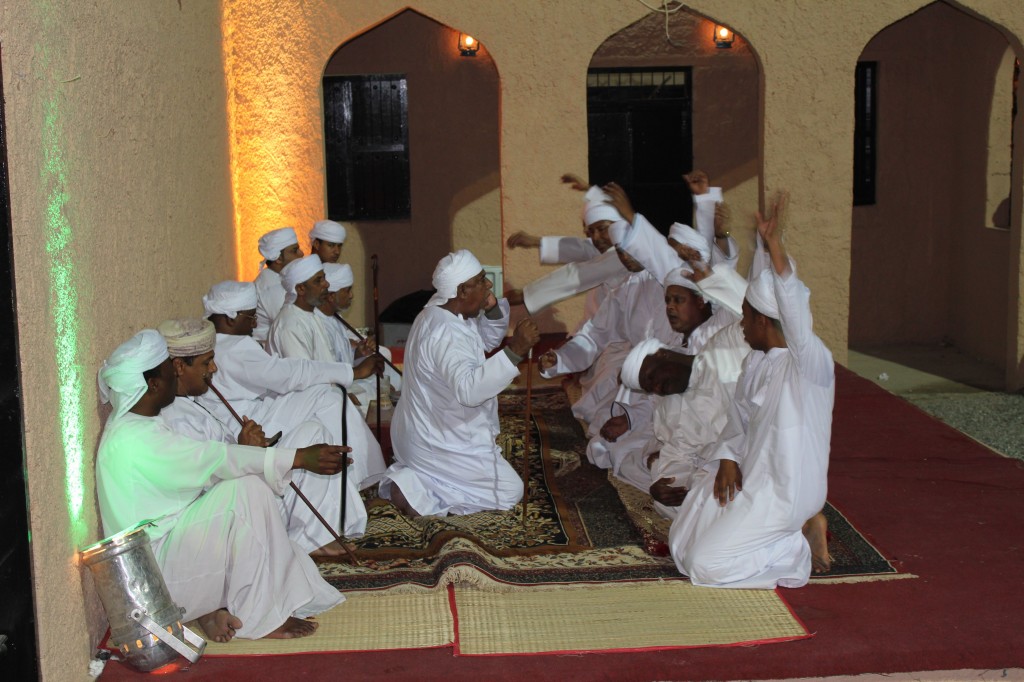
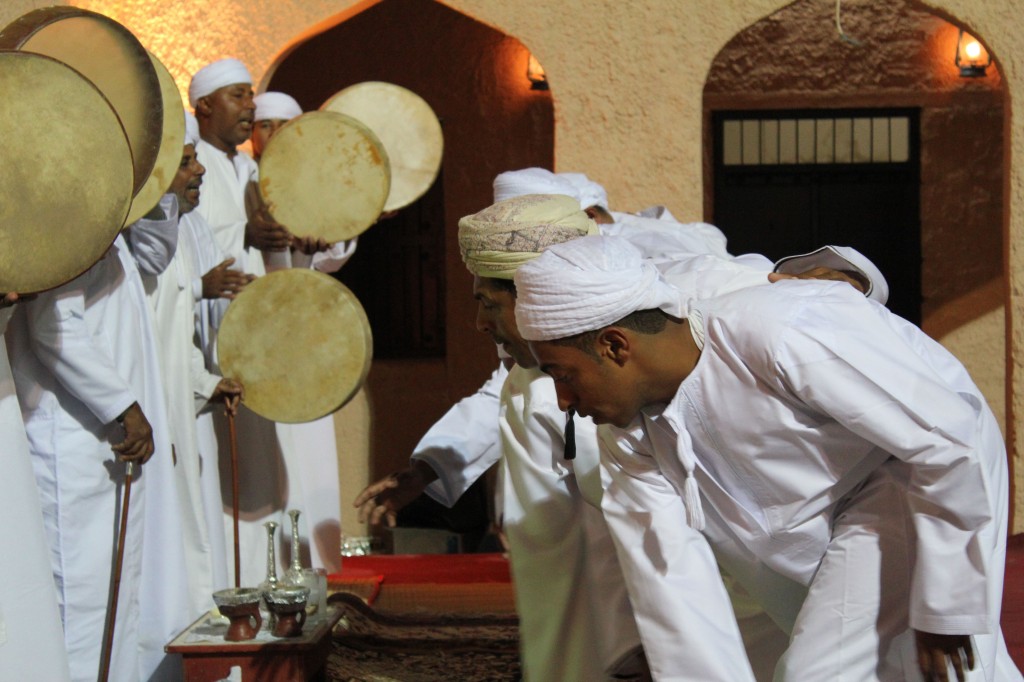
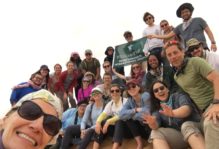
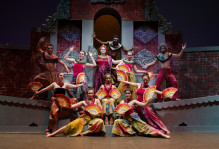
Great photos and interesting write-up, Anne.
Susan
Nice entries, Anne! I love the photos and the text is so learned. Do you travel with all those sources in your backpack? 🙂
Looking forward to reading more!